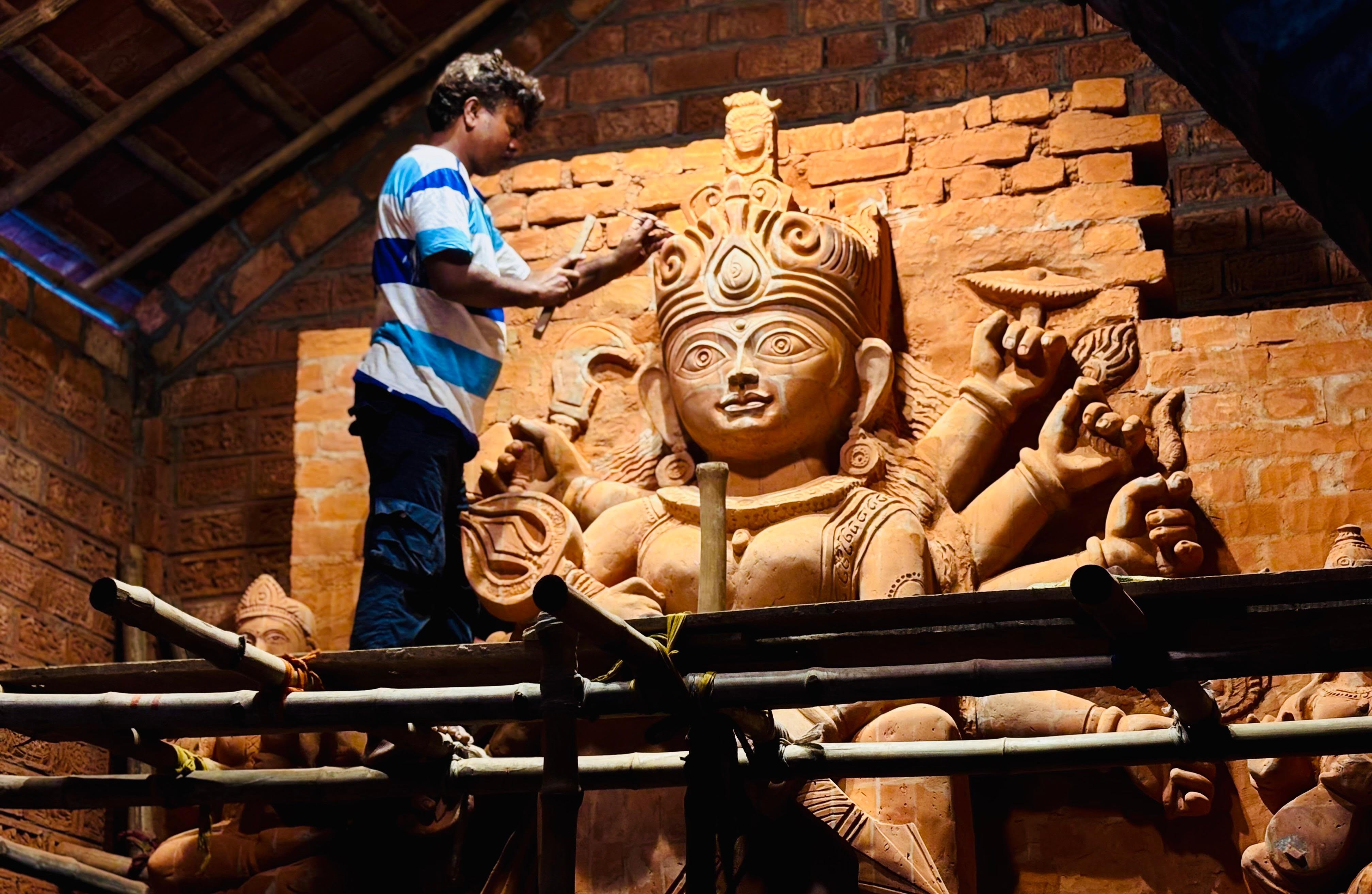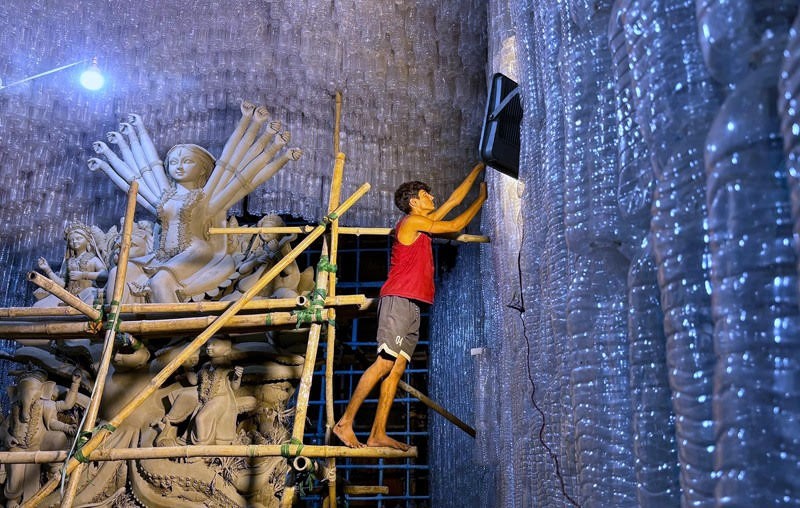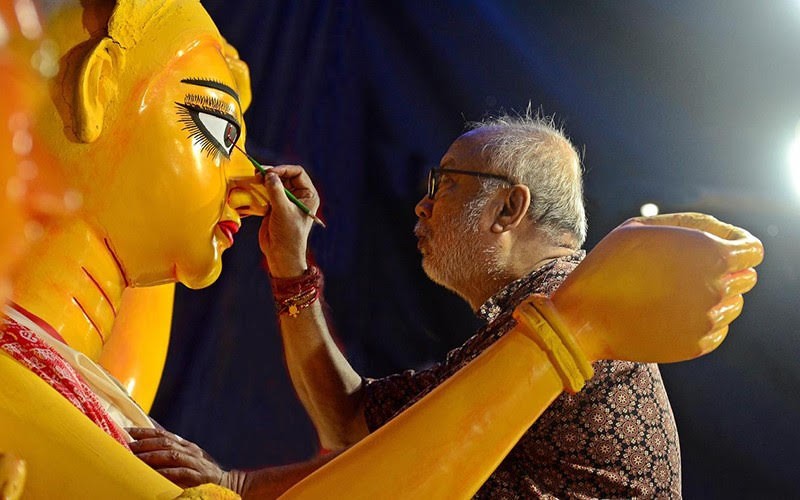Durga Puja: Bengal’s festival of faith, art and communion
As Bengal prepares for Durga Puja, the streets of Siliguri, Kolkata and Krishnanagar begin to hum with a familiar rhythm—clay being molded, pandals rising, communities gathering. But this is no ordinary festival. Durga Puja is Bengal’s civilizational heartbeat: a sacred season where devotion meets artistry, and community becomes communion.

The Goddess as Mirror and Warrior
Durga, the ten-armed Goddess, is not merely a mythic warrior from ancient lore—she is Shakti, the living embodiment of divine feminine energy that confronts chaos, injustice and moral paralysis. Her descent each year is not a seasonal spectacle but a spiritual summons: to name evil, resist it, and restore balance—not only in scripture but in the soul of society.
In a time when violence is normalized, truth silenced and fear politicized, Durga’s image becomes a mirror. She reflects not just our aspirations but our complicity. Her raised weapons are not symbols of vengeance—they are reminders of vigilance. She calls us to confront the Mahishasurs of our time: corruption, casteism, communal hatred, gender violence and ecological destruction.
“She didn’t just slay Mahishasura,” said a young sculptor in Ghurni, giving final touches to a Durga statue. “She slays our despair, our fear, our silence.”
 A theme puja idol in the making in Kolkata. Photo: Avishek Mitra/IBNS
A theme puja idol in the making in Kolkata. Photo: Avishek Mitra/IBNS
In the hands of Bengal’s artisans, Durga is not frozen in mythology—she is reimagined as a mother, a migrant, a protester, a healer. Her face carries the anguish of the oppressed and the defiance of the prophetic. She is not distant; she is dangerously close to our conscience.
To worship Durga is to awaken. To carry her idol is to carry her courage. And to immerse her in the river is to recommit ourselves to the struggle she embodies.
Art as Worship, Worship as Public Culture
The spiritual core of Durga Puja is inseparable from its cultural grandeur. It is not confined to temple rituals or private devotion—it spills into the streets, into sculpture, sound and spectacle. UNESCO’s 2021 recognition of Kolkata’s Durga Puja as Intangible Cultural Heritage affirms what Bengalis have long practiced: art is worship, and worship is public.
Every brushstroke, bamboo frame and rhythmic drumbeat becomes an offering. From Kumartuli’s clay idols—sculpted with riverbed soil and ancestral memory—to pandals that mimic temples, trains, refugee camps or global landmarks, Durga Puja is a canvas of collective creativity. It is where theology meets theatre, and civic imagination becomes sacred space.
Here, artisans are theologians. Their hands preach what pulpits cannot. A pandal may resemble a South Indian temple, a Himalayan monastery or a collapsing glacier—each telling a story of faith, fragility and resistance. In this way, Durga Puja becomes Bengal’s most eloquent form of public theology: a liturgy of light, labor and longing.
 Artisans in Kolkata are building a Durga Puja pandal for Lalabagan Nabankur themed “Karagar” using discarded plastic bottles to highlight the menace of ocean pollution. Photo: Avishek Mitra/IBNS
Artisans in Kolkata are building a Durga Puja pandal for Lalabagan Nabankur themed “Karagar” using discarded plastic bottles to highlight the menace of ocean pollution. Photo: Avishek Mitra/IBNS
Themes That Speak to the Times
This year, Kolkata’s pandals have reached new heights of imagination. Sreebhumi Sporting Club has recreated the Swaminarayan Akshardham Temple of New Jersey, its milky-white façade adorned with golden elephants. Santosh Mitra Square pays tribute to India’s armed forces with Operation Sindoor, a theme rooted in valor and remembrance. Deshapriya Park is reviving its 2015 feat with an 88-foot Durga idol, while Ekdalia Evergreen Club draws inspiration from Tamil Nadu’s Arunachaleswarar Temple.
Elsewhere, Agarpara Tarapukur offers a Kumbh Mela-inspired pandal, complete with symbolic holy dips and celestial motifs. Jirat Adi Barowari and Kalyani Rath Tala showcase Swaminarayan temples from London and America, blending bamboo architecture with vibrant glasswork. Tala Prattoy celebrates its centenary, and Ballygunge Cultural marks its 75th with immersive storytelling. A striking trend this year is the fusion of mythology and artificial intelligence, with several clubs exploring how technology intersects with spirituality—raising questions about consciousness, divinity and the digital age.
Sacred Hands, Silent Prayers
For Bengal’s statue makers, Durga Puja is not merely a season of commerce—it is a sacred vocation rooted in ancestral memory and spiritual labor. These artisans, often working in cramped studios along the lanes of Kumartuli or suburban workshops in Krishnanagar, do not just shape clay—they shape consciousness. Their hands carry centuries of tradition, transforming riverbed soil into divine presence, and silence into sculpture.
“In Durga Puja, clay becomes divinity, and craftsmanship becomes worship,” said Subrata Ganguly, CEO of Church Art Kolkata, which supplies religious statues across India. “Every idol we sculpt carries the emotion of millions, the legacy of generations, and the silent prayer of the artisan’s hand.”
These artisans are often invisible in the final celebration—rarely named, seldom honored. Yet their work is prophetic. In each curve of Durga’s brow, each gesture of her hand, they embed stories of struggle, resilience and hope.
From Zamindars to the People
Durga Puja is also a stage for social solidarity. Historically a zamindari ritual, it became a people’s festival through the Baroyari movement.
The Baroyari movement, rooted in the spirit of baro-yari or “twelve friends,” began in 1790 in Guptipara, Hooghly district, when a group of young men organized a Durga Puja open to the public—breaking away from private aristocratic worship. Their vision was radical: to make the festival inclusive, allowing ordinary people to participate in devotion and cultural expression. This grassroots initiative laid the foundation for what is now known as Sarbojanin Durga Puja—a festival “for all people.”
By the early 20th century, especially during the Swadeshi movement, Baroyari Puja evolved into a platform for nationalist mobilization, with pandals showcasing freedom fighters, anti-colonial themes and indigenous art. It democratized religious space, transforming Durga Puja into a civic ritual where faith, creativity and political consciousness converged.
 Artisan Sanatan Rudra Pal is seen painting the eyes of Ma Durga. Photo: Avishek Mitra/IBNS
Artisan Sanatan Rudra Pal is seen painting the eyes of Ma Durga. Photo: Avishek Mitra/IBNS
Faith Without Borders
In an age when religious identities are weaponized and communities polarized, Durga Puja in Bengal offers a counter-witness—an inclusive space where faith becomes fellowship. The festival draws in Hindus, Christians, Muslims, Sikhs, Buddhists and atheists alike, not through dogma but through shared devotion, artistry and celebration. Volunteers, artisans, sponsors and devotees co-create the experience, blurring lines of caste, class and creed.
“Durga Puja is our shared prayer,” said an Adivasi catechist in Jalpaiguri. “Even if our gods differ, our longing is the same.”
A Counter-Narrative of Hope
Politically, Durga Puja has long been a site of resistance. During colonial rule, it became a platform for nationalist mobilization, with the goddess reimagined as Bharat Mata—a motherland under siege inspiring poets, freedom fighters and cultural reformers.
But resistance did not end with independence. In today’s India, where dissent is branded as disloyalty and identity is politicized, Durga Puja continues to offer a quiet counter-narrative. Pandal themes now speak to ecological crisis, gender justice and constitutional values. Clubs have depicted farmers’ struggles, refugee journeys and the plight of manual scavengers—challenging viewers to confront uncomfortable truths.
As Bengal lights its lamps, it does not merely celebrate tradition—it reclaims its moral imagination. Durga Puja becomes a civic liturgy of resistance, where the divine is not distant but dangerously close to the wounds of the world.
IBNS
Senior Staff Reporter at Northeast Herald, covering news from Tripura and Northeast India.
Related Articles

CBSE releases tentative date sheets for 2026 Class 10 and 12 board exams. Check details
The Central Board of Secondary Education (CBSE) has announced the tentative date sheets for the 2026 Class 10 and 12 board examinations.

Rotary International District 3291 joins hands with JU, others to celebrate sustainable Durga Puja
Recognizing the scale and influence of the festival, Rotary International District 3291, in association with Variable Energy Cyclotrone Centre ( DOE, GOI), Jadavpur University and Central Pollution Control Board (under Ministry of Environment, GOI), is launching a first-of-its-kind initiative to promote a sustainable Durga Puja.
Kartik Aaryan launches new Skechers store in Kolkata
Kolkata/IBNS: Bollywood star Kartik Aaryan recently launched a new store of Skechers in Kolkata' South City Mall.

Saptak Music School of Pittsburgh hosts spellbinding evening of Indian classical music
Pittsburgh/IBNS: The Saptak Music School of Pittsburgh, in collaboration with the Music Department of Chatham University, staged a captivating evening of Indian classical music that drew students, connoisseurs, and the wider community into a celebration of India’s cultural heritage.
Latest News

BSF Tripura organizes blood donation camp

Higher Education Minister releases NLU Tripura’s project report on handholding support to 480 GPs/VCs

Asia Cup: Suryakumar Yadav fined for ‘Pahalgam tribute’, Pak player Haris Rauf penalised for aggressive behaviour

40 minor girls found locked in toilet at illegal madrasa in UP

